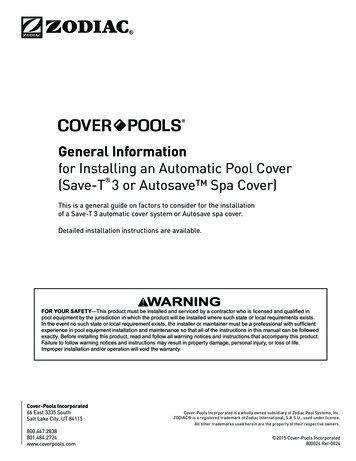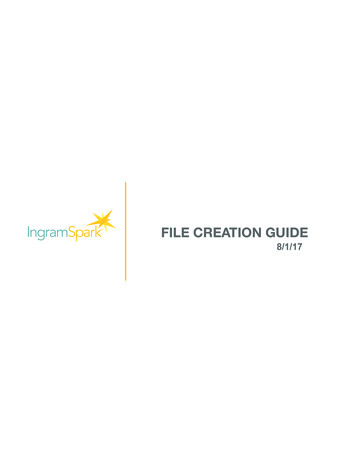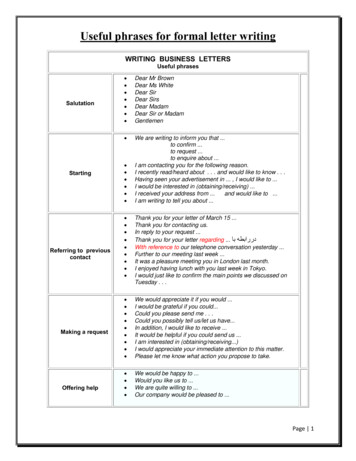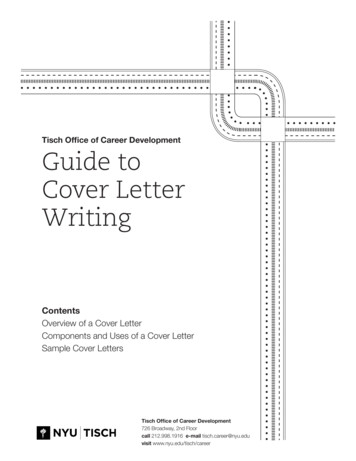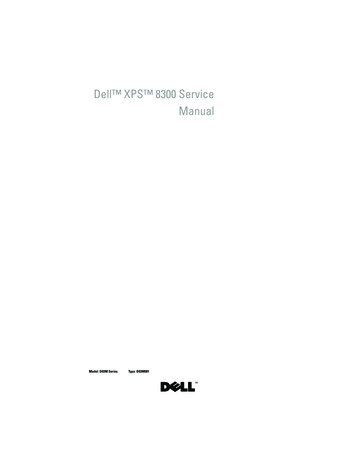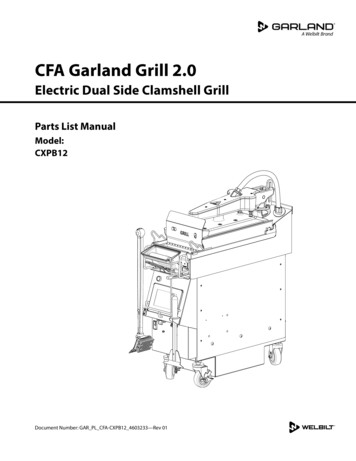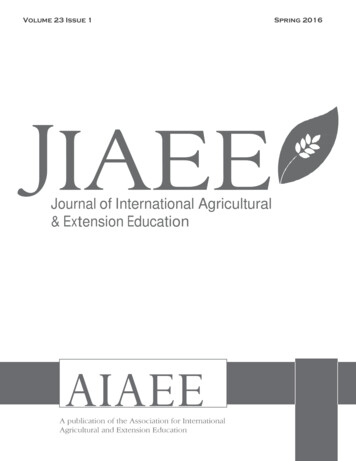
Transcription
Volume 23 Issue 1Journal of International Agricultural and Extension EducationJournal of International Agricultural& Extension EducationAIAEESpring 2016Volume 23, Issue 1
Journal of International Agricultural and Extension EducationVolume 23, Issue 1Journal of International Agricultural and Extension EducationISSN 1077-0755DOI Prefix 10.5191aiaee.orgThe Journal of International Agricultural and Extension Education (JIAEE) is the official refereedpublication of the Association for International Agricultural and Extension Education (AIAEE). Thepurpose of the JIAEE is to enhance the research and knowledge base of agricultural and extensioneducation from an international perspective. Acceptance rates for the past three volumes are: Volume 19 20%, Volume 20 21%. Volume 21 13%. Volume 22 18%Articles intended for publication should focus on international agricultural education and/or internationalextension education. Articles should relate to current or emerging issues, cite appropriate literature, anddevelop implications for international agricultural and extension education. Manuscripts, or portions ofmanuscripts, must not have been published or be under consideration for publication by anotherjournal. Three types of articles are solicited for the JIAEE: Feature Articles, Tools of the ProfessionArticles, and Book Reviews.Feature ArticlesFeature articles focus on philosophy, current or emerging issues, and the methodology and practicalapplication of specific research and appropriate technologies, which have implications for developed anddeveloping countries. For publication in the JIAEE, feature articles must pass the JIAEE’s double blind,referee process, where peer reviewers evaluate manuscript content and ensure readability. Reviewers areselected from the AIAEE membership. In the double blind, referee process, all references to authors areremoved before the manuscript is sent to reviewers. Feature articles may be submitted for peer review atotal of three times before they are no longer acceptable for publication in the JIAEE. Failure to meet thesubmission formatting guidelines will result in an automatic first rejection.Other Article TypesCommentary articles state an opinion, offer a challenge, or present a thought-provoking idea on an issueof concern to international agricultural and extension education, including a published article in theJIAEE. These articles are invited by the editors. Tools of the Profession articles report specifictechniques, materials, books and technologies that can be useful for agricultural and extension educatorsin a global context and/or in a country/region. Book Reviews provide insight on current books related tointernational agricultural education.SubscriptionsSubscriptions may be acquired online at https://www.aiaee.org/index.php?Itemid 147. The individualmembership rate of 70 provides a yearly subscription to the online journal. Domestic and internationallibraries and subscription agencies may register their IP range for online access for subscribers for 150per year.2
Journal of International Agricultural and Extension EducationVolume 23Issue 1Volume 23, Issue 1Spring 2016Editorial Board and Leadership Team . 4From the Executive Editor . 6CommentaryHow Will Extension Contribute to the Sustainable Development Goals? A Global Strategy andOperational Plan . 7Kristen Davis, International Food Policy Research Institute/Global Forum for RuralAdvisory ServicesFeature ArticlesDecentralization of Mexico’s Agricultural Extension Services and the Ongoing Struggle toAlleviate Rural Poverty . 14José M. Uscanga, Oklahoma State UniversityM. Craig Edwards, Oklahoma State UniversityUniversity Student and Faculty Needs, Barriers, and Expectations of International Efforts andOpportunities: A Closer Look at One Land-Grant University’s College of Agriculture . 33Stuart Estes, University of ArkansasMaggie Jo Hansen, University of ArkansasLeslie D. Edgar, University of ArkansasMotivations to Study Abroad: A Case Study of the College of Agricultural and Life SciencesAgribusiness Short-Term Study Abroad Program . 48Amber Lynn Beseli, North Carolina State UniversityWendy J. Warner, North Carolina State UniversityBarbara M. Kirby, North Carolina State UniversityDavid W. W. Jones, North Carolina State UniversityImpact of Teachers on an Australian Community Over Ten Years: A Qualitative Study . 60Derek Brawner, University of TennesseeCarrie Ann Stephens, University of TennesseeShelby Brawner, University of TennesseeChristopher T. Stripling, University of TennesseeNeal Samuel Eash, University of TennesseeFactors Influencing Self-Efficacy and Adoption of ICT Dissemination Tools by New ExtensionOfficers . 72Wayne G. Ganpat, University of the West Indies, St. Augustine, Trinidad and TobagoJeet Ramjattan, University of the West Indies, St. Augustine, Trinidad and TobagoRobert Strong Jr., Texas A&M UniversityManuscript Submission Guidelines . 863
Journal of International Agricultural and Extension EducationVolume 23, Issue 1Editorial BoardThe editorial board consists of the editors, the past editor and other members representing regions of theworld.EditorsRobert Strong Jr., Executive EditorTexas A&M University2116 TAMUCollege Station, TX 77843-2116jiaee@aiaee.orgKristina Ricketts, Managing EditorUniversity of Kentucky713 Garrigus BuildingLexington, KY 40546-0215jiaee@aiaee.orgAmy Harder, Past EditorUniversity of FloridaP.O. Box 112060Gainesville, FL 32611-2060Craig Edwards, Associate EditorOklahoma State University456 Agricultural HallStillwater, OK 74078Association for International Agricultural and Extension Education OfficersRenee Pardello, PresidentUniversity of Minnesota260 Coffey Hall1420 Eckles Ave.St. Paul, MN 55108Amy Boren, SecretaryTexas Tech UniversityBox 42131Lubbock, TX 79404-2131Kristin Davis, Past-PresidentGlobal Forum for Rural Advisory Servicesc/o University of PretoriaPrivate Bag X 20 Hatfield 0028South AfricaAnita Zavodska, TreasurerBarry University4900 S. University DriveSuites 203-205Davie, FL 33328Amy Harder, President-ElectUniversity of FloridaP.O. Box 112060Gainesville, FL 32611-2060Wayne Ganpat, Board Member-at-LargeDepartment of Agricultural Economics andExtensionFaculty of Food and Agriculture UWICircular Rd., St. Augustine, Trinidad, W.I.Baleshka Brenes,Graduate Student RepresentativeTexas Tech UniversityBox 42131Lubbock, TX 79404-21314
Journal of International Agricultural and Extension EducationVolume 23, Issue 1U.S./World RepresentativesJ. C. BunchLouisiana State UniversityBaton Rouge, LA, USAMercy AkeredoluWinrock Rep., NigeriaKano, NigeriaDavid DollyUniversity of West IndiesSt. Augustine, Trinidad and TobagoMartin MulderWageningen URWageningen, The NetherlandsTim KockNorthern Marianas CollegeSaipan, MPChukiat RuksornKasetsart UniversityNakorn Pathom, ThailandMike McGirrUSDA-CSREESWashington, DC, USAAnita ZavodskaBarry UniversityDavie, FL, USALeslie EdgarUniversity of ArkansasFayetteville, AR, USATodd BrashearsTexas Tech UniversityLubbock, TX, USA5
Journal of International Agricultural and Extension EducationVolume 23, Issue 1From the Executive EditorI am honored and excited for my new role as the executive editor for the JIAEE. We recentlyparticipated in the annual AIAEE conference in Portland, USA. It is always inspiring to learn theinnovative agricultural and extension education inquiries that were and are being conductedaround the world. I do hope that authors think about expanding their abstracts into manuscriptsubmissions for the JIAEE. There are many examples of high quality scholarship that getspresented at our annual conference but does not get formatted and submitted to the JIAEE forreview. I encourage all presenters to review the submission guidelines and format yourscholarship for potential publication in the JIAEE. Submission guidelines are located es.A commentary and five feature articles are included in the first issue of Volume 23. Thecommentary shares to how the Global Forum for Rural Advisory Services (GFRAS) plan toaddress the United Nation’s Sustainable Development Goals. The first feature article offers anhistorical inquiry that described the impact of decentralization on Mexico’s national agriculturalextension system. The second article identifies university student and faculty needs, barriers, andexpectations of international efforts and opportunities at the University of Arkansas. The thirdpiece provides a better understanding of the student participants’ motivations to partake in ashort-term study abroad experience. The fourth feature article provides an evaluation of theimpact of agricultural teachers on a rural community in Australia. The final article focuses on theself-efficacy and adoption of ICTs tools by new extension officers in Trinidad and Tobago. Ihope you discover the diversity of scholarship in this first issue to be informative and advancingour literature to meet both the needs of scholars and practitioners.Sincerely,Robert Strong Jr.Executive Editor, JIAEE6
Journal of International Agricultural and Extension EducationVolume 23, Issue 1doi:10.5191/jiaee.2016.23101CommentaryHow Will Extension Contribute to the Sustainable Development Goals?A Global Strategy and Operational PlanKristin DavisInternational Food Policy Research Institute/Global Forum for Rural Advisory ServicesAbstractExtension remains a critical institution for supporting rural livelihoods and the SustainableDevelopment Goals. The Global Forum for Rural Advisory Services (GFRAS) recently launcheda ten-year strategic framework and five-year operational plan, both aligned to the SustainableDevelopment Goals. The strategy was developed using a series of online and face-to-faceconsultations within the Forum, with expert feedback at various stages. Using both anagricultural innovation systems and a capacity development framework, the strategy outlinesstrategic fields of action at three levels – individual, organizational, and system. The strategicfields of action include advocacy and support for increased investment in extension;professionalization; and knowledge generation and exchange. Activities in each strategic fieldwill strengthen capacities at the three levels. For each strategic field, there are expected highlevel strategic outcomes (changes in behavior) to which GFRAS will contribute. The strategy isaccompanied by a five-year operational plan, which guides the GFRAS community on how toimplement the strategic framework. Though these documents, GFRAS can effectively support theinternational extension community to contribute to the Sustainable Development Goals.Key Words: extension, advisory services, sustainable development goals, strategy7
Journal of International Agricultural and Extension EducationIntroductionExtension remains a criticalinstitution to meet the new SustainableDevelopment Goals and ensure productiveand fulfilling lives for farmers and otherrural dwellers. The Global Forum for RuralAdvisory Services (GFRAS) has become aglobally-recognized body advocating for andsupporting extension since its inception in2010. The GFRAS is mainly composed ofregional-level networks, national forums,and universities and other organizationsworking in extension.The GFRAS had an initial strategicplan for the years 2010-2015. However, it isuseful to revisit and revise organizationalstrategies on a periodic basis and in responseto changing circumstances. The new strategyis timely because the MillenniumDevelopment Goals expired in 2015. In2012 at the Rio 20 event, United Nationsmember states agreed to develop a set ofSustainable Development Goals (SDGs).The SDGs provide 17 goals and 169indictors to frame and measure the globaldevelopment agenda over the next 15 years.They focus on eradication of poverty whilesustainably using natural resources andaddressing issues of gender equality andempowerment (United Nations, 2015). TheGlobal Forum for Rural Advisory Servicesbelieves that extension has a critical role toplay in all of these areas. Thus in line withthis agenda, GFRAS has produced a tenyear strategic framework for the period2016-2025.The strategy is accompanied by afive-year operational plan. This is amedium-term document that guides theGFRAS community on how to implementthe strategic framework. The operationalplan provides a robust framework toaccomplish and measure the organizationalgoals identified in the GFRAS strategicframework (Global Forum for RuralAdvisory Services, 2016).Volume 23, Issue 1Theoretical FrameworkAgriculture is critical to the lives ofover half a billion rural people, andextension and advisory services are one ofthe main institutions who support thesepeople with advice and other services.However, extension faces many challengesto supporting rural people to improve theirlives. As a result, scholars have advocatedfor strengthening the capacities of extensionat the individual, organizational, and systemlevel to ensure relevant, efficient, effective,and sustainable services (Davis & Sulaiman,2014).Agricultural innovation systems arethe set of inter-related actors who contributeto agricultural innovation processes. Theinnovation systems also include theinteractions between these actors and theinstitutions (rules of the game) that governtheir interactions (Spielman, 2005).Using an agricultural innovationsystems approach rather than the outdatedlinear approach to development has majorimplications for extension’s role andcapacities. In addition to traditionalfunctions such as promoting technologies,giving demonstrations, and teachingfarmers, in an innovation systemsperspective, extension agents are mustfacilitate interactions with market actors andmanage innovation platforms (among otherroles) (Davis & Sulaiman, 2014). New rolesmean new capacities (skills and abilities toperform their job).The new extensionist document laysout the roles, capacities, and strategiesneeded for extension to effectively fulfill itsrole in agricultural innovation systems(Davis and Sulaiman, 2014). Using aconceptual framework developed by theFood and Agriculture Organization (2010),the new extensionist calls for strengtheningcapacities at the individual, organizational,and system levels. The new GFRAS strategyis rooted in the same conceptual framework8
Journal of International Agricultural and Extension Educationof agricultural innovation systems andcapacity development at these three levels.Volume 23, Issue 1subject matter experts who used an onlinesurvey developed in Qualtrics, an onlinesurvey tool that was reviewed by a panel ofexperts (Global Forum for Rural AdvisoryServices, 2016).The GFRAS secretariat identifiedpotential respondents, who were contactedusing the Tailored Design Method (Dillman,Smyth, & Christian, 2009). Out of 35individuals were invited to respond, 21completed the survey and 11 completed apartial response, for a 91.4% response rate(Global Forum for Rural Advisory Services,2016). Survey data were analyzed usingSPSS and Microsoft Excel.Purpose and ObjectivesThe GFRAS Strategic Framework2016-2025 is targeted at the GFRAScommunity, which includes regionalnetworks, thematic working groups, funders,members, and individual affiliates. Thedocument presents the framework throughwhich GFRAS aims to fulfill its vision andmission for the period. It explains whyGFRAS was created, why a new strategy isneeded, what the forum wants to achieve,and how this will be done (Global Forum forRural Advisory Services, 2015).GFRAS seeks to create impact at thefarmer level through its regional networksand country forums. The new strategicframework, accompanied by a five-yearoperational plan, will allow the forum toplan and measure change, learning, andprogress in extension and advisory servicesreform over the next ten years.ResultsThe strategy discussions with theGFRAS community on where it shouldfocus in the next 10 years led to threestrategic fields of action. Each of thesestrategic focuses action at the three levels ofcapacity development: Individual,organizational, and system level. They area) Advocacy and support for anenabling policy environment andappropriate investment in ruraladvisory services (RAS; also calledextension services);b) Professionalization of rural advisoryservices; andc) Facilitation and enhancement ofeffective and continuous knowledgegeneration and exchange.Extension needs policy advocacy tosupport its work. Having an explicit policyon extension helps to create an enablingenvironment that allows extension actors towork more effectively. In addition,extension organizations and individuals needto be able to advocate for increased fundingand support from governments and donors.Finally, there is a need for increasedinvestment in extension services.Extension services have long beenunder-resourced and face problems ofMethodsThe GFRAS steering committeewanted the regional networks and othermembers and affiliates to have a strongvoice in and ownership of the strategy,rather than to lead a process that was biasedtoward the GFRAS secretariat or theforum’s donors. Thus the strategicframework was produced through a series ofdemand assessments within the GFRASnetwork, electronic consultations, feedbackrounds, discussions by the GFRAS steeringcommittee, and expert input. The GFRASused a balanced scorecard approach, astrategy tool that analyzes four areas of anorganization: the customer perspective, thefinancial perspective, the learning andgrowth perspective, and the business processperspective (Kaplan & Norton, 1993).The operational plan was developedfrom perspectives of key stakeholders and9
Journal of International Agricultural and Extension Educationmotivation and incentives. Extension isoften seen as an unsuitable or non-viablecareer choice. Professionalization of theservices will address several issuessimultaneously: Improving the image ofextension, attracting more people into theprofession, and making extension servicesmore impactful.Many extension agents work in ruralareas with very little opportunity for peerexchange and continued learning. Similarly,most extension institutions do not havemany opportunities for exchange of ideasand knowledge through regular meetings orplatforms with which to share knowledge.Evidence is also lacking as to the real impactVolume 23, Issue 1of many types of extension approaches.Thus GFRAS will work to fosteropportunities to exchange knowledge, inaddition to creating and sharing knowledgethrough research, meetings, and onlineexchange platforms.Within the 10-year strategicframework, the five-year operational planprovides a framework and steps to meet thesix higher-level organizational goalsidentified in the framework using specificindicators (see Table 1). Through thesegoals GFRAS hopes to strengthen extensionand thus contribute to the SustainableDevelopment Goals.10
Journal of International Agricultural and Extension EducationVolume 23, Issue 1Table 1GFRAS Organizational Goals and IndicatorsGoalIndicators1. Increased recognition of RAS is newly integrated in three global or regionalRAS in policies andrural development programmes or frameworks byinvestments2020 Monetary investments in GFRAS have increased by10% by 20202. Strengthened RAS At least five regional networks reportperformanceprofessionalization capacity has increased by 25%between 2016 and 2020 At least two regions report offering an improvedtraining and education standard for RAS providersbased on the philosophy of the new extensionist by20203. Enhanced learning in RAS At least five regional networks report knowledgemanagement capacity has increased by 25% between2016 and 2020 RAS providers and clientele have at least oneopportunity per year to share information, knowledgeand experience in at least three regions by 20204. Strengthened enabling Three global policymakers or institutions recognizeenvironment for RAS to usethe importance of RAS furthering agriculturaltheir potential andinnovation systems by 2020effectively fulfil their roles At least four regional or country level institutions orkey people (development agencies, ministries,policymakers, donors, investors, and programmanagers) openly recognize the need for moreprofessionalization of RAS by 20205. Functionally strengthened At least five regional networks report organizationalregional networksefficiency and effectiveness has improved by 25%between 2016 and 2020 At least five regional networks have increased thedensity and strength of their internal and externalconnections by 20206. Appropriate and At least four regional or country level institutions orcomprehensive humankey people (development agencies, ministries,resources developed in RASpolicymakers, donors, investors, and programmanagers) recognize RAS professionals’ skills relatedto furthering agricultural innovation systems haveincreased by 2020 At least three regional networks report increasing theirability to improve human resource development ofRAS professionals by 202011
Journal of International Agricultural and Extension EducationVolume 23, Issue 1Note. From GFRAS five-year operational plan 2016-2020 by Global Forum for Rural AdvisoryServices, 2016, Global Forum for Rural Advisory Services. Reprinted with permission of theauthor.experts, AIAEE members can contributeto designing and evaluating moreConclusionsWhat does this mean foreffective systems. Members with skills inextension professionals and for thehuman resource development canAssociation for International Agriculturalcontribute to the on-going learningand Extension Education (AIAEE) inactivities and those with advocacy skillsparticular? As per the AIAEEto the policy work. Those with goodconstitution, “the AIAEE is anknowledge of monitoring and evaluationorganization dedicated to developing newcan contribute to monitoring andprograms in agricultural and extensionmeasuring the operational plan. Finally,education and improving or strengtheningthe association can provide a medium forexisting programs and institutions ofdiscussion and debate on the extensioneducation to have a positive impact oncontributions to the Sustainabledevelopment efforts worldwide. TheDevelopment Goals through the annualAIAEE shall work toward improving theconference and the journal.understanding of agricultural andextension education in differentReferencesinternational settings among public andAssociation for Internationalprofessional groups concerned withAgricultural and Extensiondevelopment. The AIAEE shall maintainEducation. (2014). Constitutionliaison and working relationships withof the Association forsuch groups and institutions and shallInternational Agricultural andprovide a medium for the exchange ofExtension Education. Collegeideas and information relating toStation, Texas: Association forprograms of international agricultural andInternational Agricultural andextension education” (Association forExtension Education.International Agricultural and ExtensionDavis, K. & Sulaiman, R. V. (2014). TheEducation, 2014, para. 1).“new extensionist”: Roles andcapacities to strengthen extensionThe GFRAS strategy and operationaland advisory services. Journal ofplan lay out key areas for research andAgricultural Education andpractice in the next 10 years in which theExtension 21(3), 6-18.association is well-placed to engage indoi:10.5191/jiaee.2014.21301line with the constitution. As anDillman, D. A., Smyth, J. D., &association committed to strengtheningChristian, L. M. (2009). Internet,and improving international extensionmail, and mixed-mode surveys:programs and institutions, AIAEEThe tailored design method. (3rdprofessionals can contribute to this globaled.). Hoboken, NJ: John Wileywork of knowledge generation throughand Sons.their projects and research. AIAEE canFood and Agriculture Organization.help improve the understanding of(2010). Corporate strategy onextension systems around the world. Ascapacity development. Rome,an association of global extension12
Journal of International Agricultural and Extension EducationVolume 23, Issue 1Kaplan, R. S. & D. P. Norton. (1993).Putting the balanced scorecard towork. Harvard Business ReviewSeptember-October Issue 1993.Spielman, D. J. (2005). Innovationsystems perspectives ondeveloping-country agriculture: Acritical review. InternationalService for National AgriculturalResearch (ISNAR) DivisionDiscussion Paper 2. Washington,DC: International Food PolicyResearch Institute.United Nations. (2015). Transformingour world: The 2030 agenda forsustainable development. NewYork: United NationsItaly: Food and AgricultureOrganization.Global Forum for Rural AdvisoryServices (2015). Global Forumfor Rural Advisory Servicesstrategic framework 2016–2025:Advocacy and leadership in ruraladvisory services for sustainabledevelopment. Lindau,Switzerland: Global Forum for RuralAdvisory Services. Global Forumfor Rural Advisory Services(2016). GFRAS five-yearoperational plan 2016-2020.Lindau, Switzerland: GlobalForum for Rural AdvisoryServices.13
Journal of International Agricultural and Extension EducationVolume 23, Issue 1doi:10.5191/jiaee.2016.23102Decentralization of Mexico’s Agricultural Extension Services and the Ongoing Struggleto Alleviate Rural PovertyJosé M. UscangaM. Craig EdwardsOklahoma State UniversityAbstractA tendency to decentralize national agricultural extension systems around the world caughtmany countries unprepared to respond effectively to the needs of its rural population underprivatized approaches to extension delivery, especially in regard to poverty alleviation. Myriadinternal and external factors led Mexico to dismantle its national agricultural extension systemin the 1990s, and adopt a more privatized or contractor-driven approach. As a result, significantchanges occurred in the way extension services were offered to the public after the system’sdecentralization by Mexico’s federal government, although some similarities remained. Afteralmost two decades of decentralization, the effectiveness of the current system has beenquestioned regarding its provision of services to marginalized groups who represent the mostimpoverished of Mexico’s citizens. This historical narrative aimed to understand thephenomenon by exploring the causes of decentralization, comparing extension service deliverybefore and after decentralization, including its outcome, privatization of extension services, andsuggest directions for improvement in the future.Keywords: agricultural extension; decentralization; Mexico; rural poverty14
(National Council for the Evaluation of SocialDevelopment Policy [NCESDP], 2012, p. 9).Extreme poverty comprises the “[p]opulationthat endures three or more social deprivationsand whose income is below the minimumwellbeing line” (NCESDP, 2012, p. 9).As of 2012, six social deprivationswere considered in the definition of poverty:educational gap, access to health services,access to social security, quality and spaces ofthe dwelling, access to basic services in thedwelling, and access to food (NCESDP,2012). The wellbeing line is defined as the“[m]onetary value of a food, goods, and basicservices basket” (NCESDP, 2012, p. 9). In therural areas of Mexico, 61.6% of thepopulation is impoverished, and one-third, orabout five million people, includes Mexicansliving in extreme poverty; their meagerincomes are not enough to meet dailynutritional needs (CONEVAL, 2013;NCESDP, 2012).Most of the mainly rural states inMexico have the highest poverty levels (seeFigure 1). Mexico’s southern states reportedthe highest extreme poverty rates for 2012,i.e., Chiapas 32.2%, Guerrero 31.7%, Puebla17.6%, and Veracruz 14.3% (CONEVAL,2013). Not coincidentally, these states havesome of the highest proportions of Mexico’smore than nine million indigenous people(see Figure 1) with almost one million notspeaking the Spanish language (DiarioOficial de la Federación, 2010).Introduction and BackgroundCountries need to consider that“poverty is a multidimensional phenomenon”(Van Praag & Ferrer-i-Carbonell, 2007, p. 6).In a national approach to reducing poverty, anagricultural extension system can be animportant force (Farrington, Christoplos,Kidd, & Beckman, 2002). If a nation’sagricultural extension system is to play asignificant role in reducing poverty, its ruraland agricultural contexts must be considered.We examined the decentralization ofMexico’s national agricultural extensionsystem (NAES), its replacement by a privatecontractor system, and consequencesassociated with that change. We also suggestthe proper role of Mexico’s governmentregarding agricultural extension and reducingrural poverty in the future.Rural Poverty Remains a Major Challengein MexicoThe population of Mexico was about120 million in 2013 and almost 22% of itscitizens were living in rural areas (ConsejoNacional de Población, 2013). ImpoverishedMexicans accounted for 46.1% of thecountry’s total population in 2012 (ConsejoNacional de Evaluación de la Política deDesarrollo Social [CONEVAL], 2013). Forthe Government of Mexico, the populationliving in poverty includes those “whosein
Gainesville, FL 32611 -2060 Kristina Ricketts, Managing Editor University of Kentucky 713 Garrigus Building Lexington, KY 40546 -0215 jiaee@aiaee.org Craig Edwards, Associate Editor Oklahoma State University 456 Agricultural Hall Stillwater, OK 74078 Association for International Agricultural and Extension Education Officers
